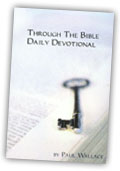3/14 Leviticus 16:8
8 And Aaron shall cast lots over the two goats, one lot for the LORD and the other lot for Azazel.
Once a year, the people of Israel celebrated the Day of Atonement. The priest would offer a sacrifice for his own sins first. Then he would take two goats and cast lots to see which goat was the sacrifice and which went to Azazel. We don't know the meaning of "Azazel." It could mean a place in the wilderness or some dark spiritual power. Traditionally it was translated "scapegoat."
The priest would place his hands on the head of the scapegoat and pronounce the sins of Israel and then someone would take it out into the wilderness and release it. The other ram was sacrificed and the blood was sprinkled before the mercy seat. We wonder why two rams were necessary to represent atonement.
Of course they both look forward to Jesus' atoning sacrifice for us on the cross. He is the sacrifice for our sins. The blood of the goat represented the penalty for sin, and then the carcass was burned outside the camp, just as Jesus was crucified outside the city. The scapegoat is a picture of our sins being removed from us. Not only are we forgiven, but we are not to return to the habits and actions of sin. Those things should be driven from us. Forgiveness is one thing, but a new life free from the habitual sin is another. That is why we needed the picture of the two rams to understand all that atonement was to mean to us.
Sometimes people come to Jesus and want their sins to be forgiven by His blood, but they don't send their sinful ways away from them. They have missed half the picture. The two go together.
Prayer: Thank you LORD for providing a means for the forgiveness of my sin and for the power to transform the way I think and act.








